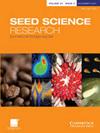Germination responses in Zephyranthes tubispatha seeds exposed to different thermal conditions and the role of antioxidant metabolism and several phytohormones in their control
IF 2.1
3区 生物学
Q2 PLANT SCIENCES
引用次数: 1
Abstract
Abstract Zephyranthes tubispatha is an ornamental species distributed along several countries of South America. Although it can be multiplied through bulbs or scales, seed germination is a simpler and more cost-effective process. Temperature plays a major role in the control of germination; however, its effect has been scarcely investigated in this species. In the present work, we characterized the germination responses of Z. tubispatha seeds to different temperatures and analyzed the role of key components of the antioxidant metabolism and phytohormones in their control. Seeds showed an optimal temperature range for germination between 14 and 20°C, with higher temperatures (HTs) being progressively inhibitory. While germination was almost nil above 28°C, it could be recovered after transferring the seeds to 20°C, suggesting that thermoinhibition was the underlying phenomenon. The duration of the HT incubation period affected both the time to germination onset and the germination rate at 20°C. Similarly, the activity of antioxidant enzymes, the production of reactive oxygen species in the embryo and the sensitivity to some germination promoters varied depending on the duration of the HT treatment. The addition of 20 μM fluridone was sufficient to recover germination dynamics as in the control treatment when given after a long-term incubation period (25 d) at HT. Ethephon supply was more effective than gibberellins to suppress thermoinhibition, suggesting that changes in the balance and/or sensitivity to ethylene and abscisic acid over time play an important role in the regulation of germination responses to thermal cues in this species.不同温度条件下泽兰种子的萌发响应及抗氧化代谢和几种植物激素在其调控中的作用
摘要:西风菊(Zephyranthes tubispatha)是分布在南美洲多个国家的观赏植物。虽然它可以通过鳞茎或鳞片繁殖,但种子发芽是一个更简单、更经济的过程。温度对发芽起主要控制作用;然而,它的作用在这个物种中几乎没有研究过。本文研究了不同温度对兔嘴豆种子萌发的影响,分析了抗氧化代谢的关键成分和植物激素在其调控中的作用。种子萌发的最佳温度范围为14 ~ 20℃,温度越高,萌发越受抑制。在28°C以上几乎不萌发,但将种子转移到20°C后可以恢复萌发,表明热抑制是潜在的现象。在20℃条件下,高温孵育时间的长短对萌发时间和发芽率均有影响。同样,抗氧化酶的活性、胚胎中活性氧的产生和对某些发芽促进剂的敏感性也因高温处理的持续时间而异。在高温下长期孵育(25 d)后,添加20 μM氟啶酮足以恢复与对照处理相同的萌发动态。乙烯利比赤霉素更有效地抑制热抑制,这表明随着时间的推移,对乙烯和脱落酸的平衡和/或敏感性的变化在调节该物种对热线索的萌发反应中起重要作用。
本文章由计算机程序翻译,如有差异,请以英文原文为准。
求助全文
约1分钟内获得全文
求助全文
来源期刊

Seed Science Research
生物-植物科学
CiteScore
3.60
自引率
4.80%
发文量
23
审稿时长
>12 weeks
期刊介绍:
Seed Science Research, the official journal of the International Society for Seed Science, is a leading international journal featuring high-quality original papers and review articles on the fundamental aspects of seed science, reviewed by internationally distinguished editors. The emphasis is on the physiology, biochemistry, molecular biology and ecology of seeds.
 求助内容:
求助内容: 应助结果提醒方式:
应助结果提醒方式:


